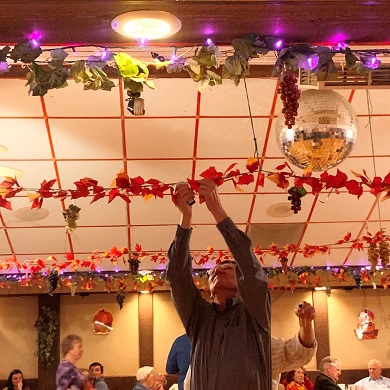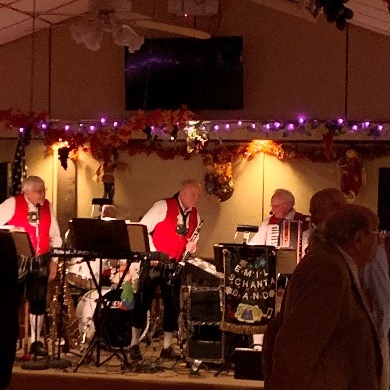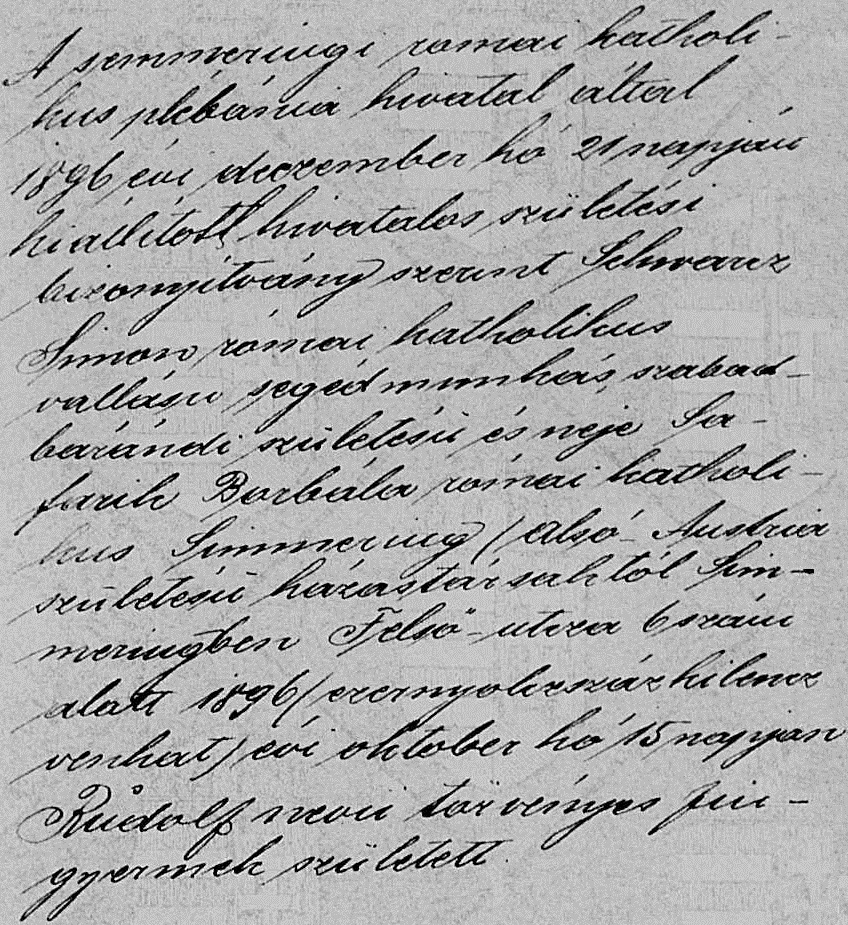|
The
|
||||||||||||||||||||||||||||||
THE BURGENLAND BUNCH NEWS - No. 302 October 31, 2019, © 2019 by The Burgenland Bunch All rights reserved. Permission to copy excerpts granted if credit is provided. Editor: Thomas Steichen (email: tj.steichen@comcast.net) BB Home Page: the-burgenland-bunch.org BB Newsletter Archives: BB Newsletter BB Facebook Page: TheBurgenlandBunchOFFICIAL Our 23rd year. The Burgenland Bunch Newsletter is issued monthly online. The BB was founded in 1997 by Gerald Berghold, who died in August 2008. |
||||||||||||||||||||||||||||||
| Current Status Of The BB: * Members: 2901 * Surname Entries: 8808 * Query Board Entries: 5777 * Staff Members: 13 |
||||||||||||||||||||||||||||||
|
||||||||||||||||||||||||||||||
1) THE PRESIDENT'S CORNER (by Tom Steichen)  This
month's collection of bits and pieces in Article 1, starts off with a tell-you-nothing-new
note (because I know nothing new) about the pending availability of Burgenland church books, follows that with a
he-can't-tell-you-anything note about the Burgenland Governor (since he had vocal cord surgery), before actually
telling you about the reburial of an Esterházy (the aristocratic land-owning family that once dominated
northern Burgenland), then telling you that we told-you-wrongly about the location of some
Eisenzicken records, and then telling you that the Lehigh Valley legend, Joe
Weber, will no longer be telling us about our ethnic history via his songs and music (he passed at age 68); all
the telling ends with a few feedback words from readers. We close Article 1 with our regular tidbit features, the
monthly BB Facebook report, book sales, a recipe and a cartoon. This
month's collection of bits and pieces in Article 1, starts off with a tell-you-nothing-new
note (because I know nothing new) about the pending availability of Burgenland church books, follows that with a
he-can't-tell-you-anything note about the Burgenland Governor (since he had vocal cord surgery), before actually
telling you about the reburial of an Esterházy (the aristocratic land-owning family that once dominated
northern Burgenland), then telling you that we told-you-wrongly about the location of some
Eisenzicken records, and then telling you that the Lehigh Valley legend, Joe
Weber, will no longer be telling us about our ethnic history via his songs and music (he passed at age 68); all
the telling ends with a few feedback words from readers. We close Article 1 with our regular tidbit features, the
monthly BB Facebook report, book sales, a recipe and a cartoon.Article 2, by Margaret Nicklas, tells about the Answers and Surprises, New Friends and Relations she found and made during her long Search for Her Grandmother’s Roots. Her grandmother probably didn't try to hide her past ...but it sure seemed that way! It turns out that one of the keys to unlocking her roots was a marginal birth entry (I decipher some example entries in Article 4 of this newsletter). However, there were many other keys, so do read Margaret's article for her full story! Article 3 is another Trip Report, making this, after a long void, consecutive newsletters with a trip report. In this one, Frank Paukowits tells us about this summer's family Trip to Austria and Hungary, sharing with us some useful tips and his evident joy in showing his daughter and her family around the Heimat. Frank, being no fool, even let his son-in-law come along (to drive, I think, so Frank could better enjoy the scenery and the Burgenländische wines! ;~). Article 4 is the third of three related articles, wherein I try to make accessible the "Marginal" Entries found in Civil Records, in this case in the Birth records. Marginal entries are those hand-written in the margins of the pre-printed "long" Hungarian birth, marriage and death records, with the form X'd out and its fields left blank. Three months ago, I worked through a marginal marriage record and, last month, we deciphered a marginal entry in the death records. We conclude this series with the marginal birth entries. The remaining articles are our standard sections: Historical Newsletter Articles, Ethnic Events and Emigrant Obituaries.  Online
Burgenland Catholic Church Books: Unfortunately, I have nothing new to report about the pending availability
of the Matriken (register books) of the Catholic Diocese of Eisenstadt. The last word was that a website
would open in October containing details about the data and access to it. However, I have seen no evidence that such a
website has opened (though I did stumble across an intriguingly-named site, locked down "in maintenance mode", that I
suspect may prove to be it). Again, once I have word of a working site, I will update this text to document it. Online
Burgenland Catholic Church Books: Unfortunately, I have nothing new to report about the pending availability
of the Matriken (register books) of the Catholic Diocese of Eisenstadt. The last word was that a website
would open in October containing details about the data and access to it. However, I have seen no evidence that such a
website has opened (though I did stumble across an intriguingly-named site, locked down "in maintenance mode", that I
suspect may prove to be it). Again, once I have word of a working site, I will update this text to document it.The Voice of Burgenland: I have two related short bits for you concerning the governmental representatives who "speak" for the citizens of Burgenland... 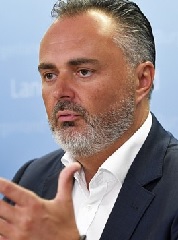 First,
Governor Hans Peter Doskozil took a few weeks off in October wherein he was not speaking for
Burgenland. It was the second time in two years that he has had vocal cord surgery intended to treat persistent hoarseness.
The previous effort was in July 2018 but did not prove sufficiently effective. The current surgery is presumed to have
resolved the rest of the problems and was reported on Doskozil's Facebook page as successful. Nonetheless, resting
his voice for a few weeks is an important part of the treatment, thus the layoff from public speaking. First,
Governor Hans Peter Doskozil took a few weeks off in October wherein he was not speaking for
Burgenland. It was the second time in two years that he has had vocal cord surgery intended to treat persistent hoarseness.
The previous effort was in July 2018 but did not prove sufficiently effective. The current surgery is presumed to have
resolved the rest of the problems and was reported on Doskozil's Facebook page as successful. Nonetheless, resting
his voice for a few weeks is an important part of the treatment, thus the layoff from public speaking.Second, since the 2015 Burgenland elections, the "middle-left" SPÖ (Social Sozialdemokratische Partei Österreichs = Democratic Party of Austria) has ruled via a coalition with the "far-right" FPÖ (Freiheitliche Partei Österreichs = Freedom Party of Austria), jointly holding 20 of the 36 seats in the Landtag (Parliament). This paralleled a similar coalition in the Austrian Federal government. However, a political scandal in the FPÖ caused the resignation of much of the FPÖ leadership and triggered a new Federal election, resulted in the "middle-right" ÖVP (Österreichische Volkspartei = Austrian People's Party) taking firm control of Austrian federal politics. The scandal also rocked Burgenland politics, causing the SPÖ to drop its alliance with the FPÖ, thus triggering an early Burgenland election, to be held later this year. The latest news is that the Burgenland SPÖ has stated it will not seek an alliance with the ÖVP. The current distribution of Landtag seats has SPÖ with 14, ÖVP 11, FPÖ 6 and 4 seats among the smaller parties. While I cannot claim to have much understanding of Burgenland nor Austrian politics, should Burgenland follow its federal model (it went 38% ÖVP, 29% SPÖ, 17% FPÖ in the federal election), SPÖ will lose seats to ÖVP in the state election, putting into question whether it will even retain a Landtag plurality (= less than a majority but still the most seats, meaning it is charged with creating a coalition government). Given the SPÖ break from the FPÖ and its unwillingness to ally with the ÖVP, its seems a very different government will be speaking for the Burgenland people once the upcoming election concludes... will we see the GRÜNE party (Die Grünen = The Greens) gain "kingmaker" status, keeping the SPÖ in power? The GRÜNE went from no seats in the current Austrian Federal government to 26 seats (based on the preliminary results of the recent federal election, to be certified October 16), which was the single largest change (the FPÖ lost 20 seats, SPÖ lost 12 and ÖVP gained 9). Stay tuned! Antal Esterházy Reburied: A member of the Esterházy family (the largest landholding aristocratic family in northern Burgenland, holders from c.1600 of the 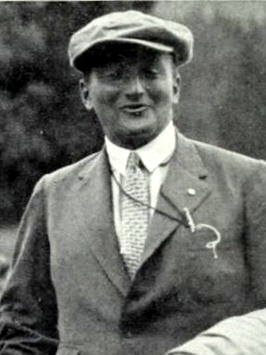 lordships
of Landsee and Lackenbach [Lánzsér-Lakompak], Forchtenstein [Fraknó] and Eisenstadt [Kismarton]) was recently removed from
the family tomb in Eisenstadt and reburied at the Eszterháza Palace in Fertőd, Hungary. lordships
of Landsee and Lackenbach [Lánzsér-Lakompak], Forchtenstein [Fraknó] and Eisenstadt [Kismarton]) was recently removed from
the family tomb in Eisenstadt and reburied at the Eszterháza Palace in Fertőd, Hungary.Antal Maria Pál Miklós herceg Esterházy de Galántha, as he was formally known, was born in 1903 at Lockenhaus, Burgenland (then Léka, Hungary) to Nikolaus IV, 11th Prince Esterházy and wife Margit Cziráky. While the role of "head of the princely house" went through his older brother Paul, it is now held by Antal's son, also Antal, who is currently 13th Prince Esterházy and family head [however, the title of Prince has no legal standing, as aristocratic/noble titles were abolished in Austria in 1919 and in 1947 in Hungary]. Antal Sr. died in 1944, at age 41, at Sárisáp, Hungary, from wounds inflicted while fighting against the Soviet communists. He was initially buried in a mass soldiers' grave but was moved in 1946 to Budapest. Later, he was moved to the family vault in Eisenstadt. Now, 75 years after his death, he has been reburied next to his wife in the family grave in Fertőd, Hungary (which is just 23 miles southeast of Eisenstadt). His son Anton Esterházy, who said that his father "was brought back to his country of birth," had tried for many years to move him back to Hungary. While no explanation was given as to why this could not be done sooner, it seems probable that the Communist government in Hungary (1949-1989) was opposed to it while they ruled. Further, all noble lands were confiscated in Hungary after WW-II, so the family no longer owned the Eszterháza Palace; I presume much negotiation took place to rebury him at what is now a state-owned property (and likely a large contribution to its restoration fund; the Palace was looted during and after WW-II and fell into disrepair; restoration began in the late 1990s and continues to this day). The Ongoing Records Chase: BB Staff member Patrick Kovacs noticed a small error... though perhaps anomaly might be a more accurate word... in our documentation of the recording location (i.e., parish) for Catholic vital events for Eisenzicken (Német-Ciklény). We listed Rotenturm an der Pinka as the appropriate parish, and that appears to be correct; at least that is what all the official gazetteers of the era say! However, Patrick discovered numerous records involving Eisenzicken in the Sankt Martin in der Wart parish, running from the beginning of the available records in 1828 through year 1862. He informed me of his discovery and I confirmed that he was right... but I also confirmed that there were numerous records for Eisenzicken for that same time period in the "official" Rotenturm parish too. So what was the deal here? Doing a little web research, I stumbled onto page unterwart.at/chronik-eisenzicken/. Eisenzicken is part of the Unterwart municipality and this was a page on the municipal website about the history of Eisenzicken. One item in the time-line history stated:
While this statement is somewhat inconsistent with the totality of the evidence available in the church
records (the duality apparently continued through 1862 rather than ending in 1855), it makes it clear that there were
two parishes serving the people of Eisenzicken and gives a logical reason for this split. While I have not gone back and
confirmed the "ethnicity" of the Eisenzicken surnames found in each parish, I have little doubt the ethnic split would prove
to be true.
A similar fix has been applied to our Villages pages. Many thanks to Patrick for bringing
this to our attention!
The original article was by Gerry Berghold and was first published in 1999. I'm sure Gerry is smiling in his grave; my
contribution was only a few nostalgia-supporting images (and, while I always appreciate thanks, I'm much more tickled that
the reprint was of value to Joe... and perhaps other readers too).
I suspect other ethnic organizations in the US also benefited (for a while) from the hard times along the border;
Anonymous gives us a specific example! Have a great day! Vanessa  Update
for book "The Burgenländer Emigration to America": Here is this month's update on purchases of the English issue of
the 3rd edition of Dr. Walter Dujmovits' book "Die Amerika-Wanderung Der Burgenländer." Update
for book "The Burgenländer Emigration to America": Here is this month's update on purchases of the English issue of
the 3rd edition of Dr. Walter Dujmovits' book "Die Amerika-Wanderung Der Burgenländer."Current total sales are 1450 copies, as interested people purchased 6 more books during this past month. As always, the book remains available for online purchase at a list price of $7.41 (which is the production charge for the book, as we purposely choose not to make a profit so we can avoid dealing with the income tax consequences and so you can obtain the book at as low a cost as possible!), plus tax & shipping. See the BB homepage for a link to the information / ordering page and for information about current discounts (there is at least one discount on price or shipping available most of the time... if not, wait a few days and there will be one!). Burgenland Recipes: Member Cris Roemer, whose family emigrated from the Weichselbaum area in the Jennersdorf district, provided this recipe. It is originally comes from a friend's Hungarian mother years ago. Ingredients: 1 cup butter 8 oz. brick of cream cheese 1/4 tsp. salt 2 cups flour apricot jam Preparation: Mix butter and cream cheese together until blended, then add salt and flour. Mixture will be sticky so put in the refrigerator for about 15 minutes. Divide the mixture into 8 equal-sized balls on a floured board. Roll each ball out into a circle. Top each with a thin layer of apricot jam, then cut the circle into 8 pie-shaped pieces. Roll each piece into a butter horn shape starting with the wide end. Place onto a cookie sheet and bake at 350 degrees for 15 to 20 minutes until golden on the bottom. When cool, frost with a powdered sugar and water mixture. Serving suggestion: Substitute either other flavored jams, or one of these alternate fillings: 1/2 tsp. cinnamon 1/4 stick melted butter 2 heaping Tbsp. brown sugar 2 egg whites 1/2 cup sugar 1/2 tsp. vanilla 1/2 cup walnuts, finely chopped  Note:
We have updated the recipes sortable list with links directly to the recipes or food-related
articles published in our past newsletters. You can access the list by clicking our recipe box (to the right). Thanks to the
contributions of our members over the years, we have quite a collection of Burgenland recipes, some with several variations. Note:
We have updated the recipes sortable list with links directly to the recipes or food-related
articles published in our past newsletters. You can access the list by clicking our recipe box (to the right). Thanks to the
contributions of our members over the years, we have quite a collection of Burgenland recipes, some with several variations.However, we have or will soon use up the few remaining unpublished recipes we have... and when those are gone, this recipe section will become dormant. Nonetheless, we are always on the lookout for fresh ideas, so, if you have a favorite family recipe, please consider sharing it with us. We will be happy to publish it. Our older relatives, sadly, aren't with us forever, so don't allow your favorite ethnic dish to be lost to future generations. You can send your recipe to BB Recipes Editor, Alan Varga. Thanks! Cartoon of the Month: 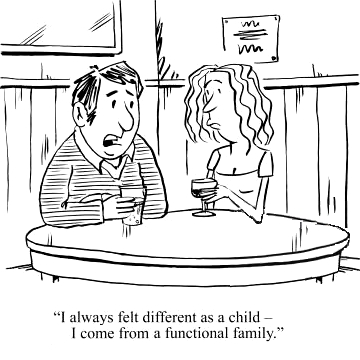 |
||||||||||||||||||||||||||||||
2) ANSWERS, SURPRISES, NEW FRIENDS AND RELATIONS: MY SEARCH FOR MY GRANDMOTHER’S ROOTS (by Margaret Nicklas) 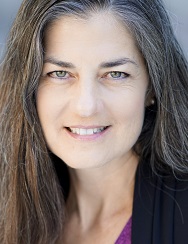 I
joined the Burgenland Bunch in December of 2014 to learn more about my family history and, in particular, about my
father's mother, about whom little was known. While in some ways I have only scratched the surface of what I originally set
out to discover, the process has already been so rewarding. I hope my story will inspire others to persevere in their own
research and to share what they can. Even small details can sometimes yield big results! I
joined the Burgenland Bunch in December of 2014 to learn more about my family history and, in particular, about my
father's mother, about whom little was known. While in some ways I have only scratched the surface of what I originally set
out to discover, the process has already been so rewarding. I hope my story will inspire others to persevere in their own
research and to share what they can. Even small details can sometimes yield big results!My story begins with my paternal grandmother, Mary (Sakasits) Nicklas, whom we knew as “Grandma Nicklas.” I never got to meet her since she died the same year I was born. Nevertheless, I have felt a life-long connection to her. 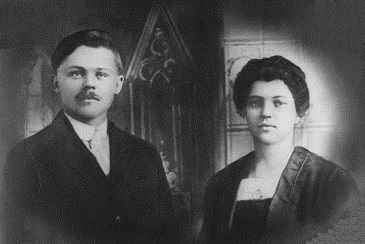 A
large, framed picture of Mary and my grandfather, Charles Nicklas, was an artifact of my childhood. In the picture,
taken on their wedding day (see right), Mary is pretty and composed. Her soulful eyes stare at the camera with a look that
is hard to read. She seems confident and strong, perhaps older than her 20 years. But how much can one glean from a single,
posed photograph? A
large, framed picture of Mary and my grandfather, Charles Nicklas, was an artifact of my childhood. In the picture,
taken on their wedding day (see right), Mary is pretty and composed. Her soulful eyes stare at the camera with a look that
is hard to read. She seems confident and strong, perhaps older than her 20 years. But how much can one glean from a single,
posed photograph?My siblings and I knew very little about this grandmother, leaving much to our imaginations. We had been told that she came from Austria to the United States on a ship, entering through Ellis Island, to make a new life. We had also been told that she was an “indentured servant” when she came and might have worked as a governess. I always assumed she came by herself and was, therefore, an orphan or something similar, as there was no mention of her having any family—just grandparents who had raised her on a farm back in Austria. We also knew that she was born out of wedlock—her father’s identity a mystery. We heard that Mary was born in Vienna, but did not know where she had grown up or, really, anything else about her, except that she was beloved by her children, a devout Catholic, enjoyed singing and was a wonderful cook. Oh how my father loved to recall the dishes and pastries she made! As a child, his relatives often said I looked like her. I was also partly named for her—my middle name is Mary (my first name is from my other grandmother). So, I had a lot of reasons to be curious about her. But the truth be told, I never delved much into the mystery until after my father passed away, leaving me with my grief and a lot of unanswered questions, which suddenly seemed more important to answer. And so I set out to see what I could learn about this woman who shaped her children’s lives but whose own origins seemed unknown even to them. Some early successes included getting a copy of her marriage license. This told me that Mary was working in a silk mill when she married my grandfather in 1919. Ship records for Charles, also a Burgenländer, showed he had traveled from Olbendorf as a youngster with an older man (whom I later determined was his grandfather) to join family already in the States. Census records showed that, early in their marriage, Mary and Charles lived in Coplay, PA, on South Front Street, where they had their first child. They later moved to nearby Catasauqua, raising nine children including my dad, who was born in 1936. 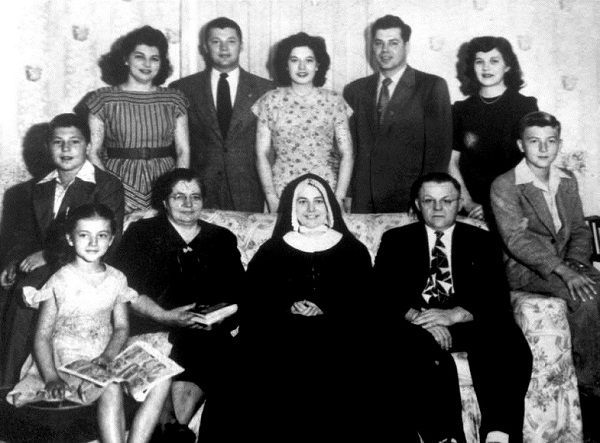 Grandmother Nicklas' Family, circa 1950, (l-r) back: Anne, Joe, Marie, Carl and Martha; front: Richard (dad), Barbara, Mary (grandmother), Hedwig, Charles (grandfather), and Robert These initial documents answered some questions but raised many more. Upon finding the record of my grandmother’s passage in 1912, I learned that her name was actually Maria, and that she hailed from a place I had never heard of called Tobaj, which did not sound very German to me. As further research would reveal, she was born in Mannersdorf am Leithagebirge and probably spent her childhood in Punitz, where her mother was from and which, therefore, was her "place of belonging."  Manifest for Szokasits Party: Anna (age 28), Frans (15), Maria (14), Edward (5), Anna (1 2/12) Though the ship manifest gave scant other information, it did reveal another surprise—that she had not come to this country alone. Rather, it showed that she had traveled with four other Szokasits, to whom, I presumed, she must be related. As further digging revealed, one of these was her older brother Frank. And there was a young married woman with her two small children, which became another mystery to solve—but more on that later. It was at this point, with the help of the wonderful folks of the Burgenland Bunch, that I began to understand the mix of cultures and ethnicities of the region, and the fact that my grandmother was probably at least part Croatian, and probably spoke some Hungarian as well as German! As my project unfolded, I was amazed to find out that my grandmother actually had lots of family members and that some had even settled in nearby communities. Yet none of us had ever heard about them. And I still don’t know whether it was just the business of life or something deeper that got in the way. In recent years, an uncle shared with me that, when my grandmother died, some “strangers” came to the funeral that no one in the family knew. I now know the descendants of some of these relatives, though I still don’t know why they and my grandmother were not closer in life. At this point, I would like to pause my story and thank the many people who have helped me put pieces of the Sakasits family puzzle together (or, if your prefer, "Szokasits," “Sokasits,” “Szokatsits,” “Szokacsits,” or Sakasitz, among other options; as all who work in the genealogy space can attest, variation in spelling is just one of many hurdles to be overcome!). While I cannot hope to mention all who have so generously helped me, there are three people I must acknowledge here. First and foremost is Thomas Steichen of the Burgenland Bunch, who answered endless questions about spellings and norms of the day, and found and translated documents for me. He has been an amazing source of support and encouragement. Andrea Wittmann, who lives near Vienna, was kind enough to track down the birth records for my great grandmother. These, and other documents she provided, gave me invaluable information going back several generations and showed that Marakovits, Frühmann and Kopeszki are surnames that are also part of my family history. And finally, Patrick Kovacs, who also lives in Vienna, has tirelessly grown the family tree we share on the Nicklas side of our respective families, while also fielding questions about the Sakasits side as he could. So, with the help of these truly dedicated individuals, and many others, here are some of the other things I now know. My grandmother actually came from a large family of at least seven children, at least five of whom survived into adulthood. By all accounts, she was the second eldest. At least two siblings settled in New Jersey—the Frank Sokasits I mentioned earlier and a sister named Paula (married name Mikovits). Even more astonishing, my grandmother’s mother, whose name, I discovered, was also Maria (last name Sokasits), lived in Coplay for a time and later in New York with a man who may have been her husband but was not my grandmother’s father. His name was Mike Meslender. These two, and at least one other Sakasits family member actually attended my grandparents’ wedding. 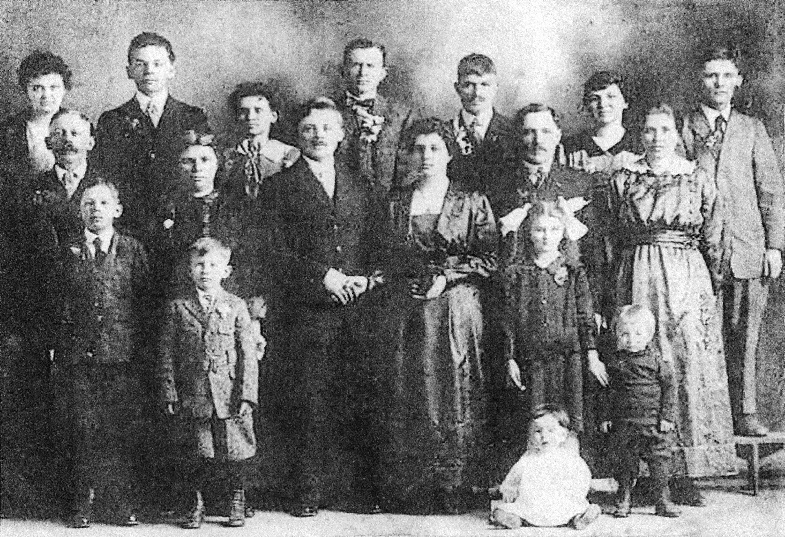 1919 group wedding photo: includes mother Maria Sokasits (woman on far right), uncle Ferdinand Sokasitz (back row, to right of bride), and Mike Meslender (to immediate right of bride) I still don’t know anything about my grandmother’s biological father, although the name on her marriage license—Frank Friedman, listed as deceased—is still the best clue I have. And there remains much more I don’t know or understand about her life. But I have come to believe that understanding more about her mother, the elder Maria, is key. Ironically, it seems the distance between this Maria and her children during her lifetime helped create the curiosity among her descendants that has brought us together in ours. For instance, I am now acquainted with the granddaughter of my great uncle Frank, Elizabeth McCormick, who lives in upstate New York. She has generously sent me family notes and pictures, and shared stories she heard growing up that could help explain the lack of close family ties. [Hint: All of the children were born out of wedlock and it’s not clear whether they shared the same father. It is said that their grandparents primarily raised them all and that they spent little time with their mother for reasons about which we can only speculate. There is also a story that the father of at least the older ones pursued her hand after she came to the United States but was refused. It is also said that this father was Jewish, and that his family initially forbade him to marry Maria, whom he met when she worked in his parents’ house at a young age. One’s imagination can surely do a lot with this kind of material—but none of these stories has yet been corroborated!] 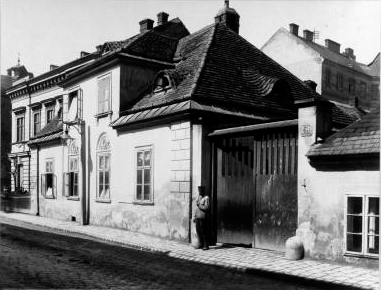 However,
the following facts are supported by birth records and other documents: Frank and my grandmother were born in 1897 and 1898,
respectively. Their mother gave birth to five additional children between 1901 and 1908: Károly, who died in infancy; János;
Paula (the sister mentioned above); a second child named Károly; and Franziska. While Frank was born in Punitz and Maria in
Mannersdorf, the others' birth records reflect various residences in Simmering, a suburb of Vienna. However,
the following facts are supported by birth records and other documents: Frank and my grandmother were born in 1897 and 1898,
respectively. Their mother gave birth to five additional children between 1901 and 1908: Károly, who died in infancy; János;
Paula (the sister mentioned above); a second child named Károly; and Franziska. While Frank was born in Punitz and Maria in
Mannersdorf, the others' birth records reflect various residences in Simmering, a suburb of Vienna.My great-grandmother left Burgenland for the United States in 1909. According to a census record, she was working in a private household in Passaic, NJ, in 1910. By 1918, she was living in Coplay with Mike Meslender (based on his World War I registration card). Through my research, I have also learned that my grandmother had several uncles (the elder Maria’s brothers) two of whom settled nearby. One of these was Ferdinand Sokasitz (pictured in the group wedding photo above), who settled in Nazareth, PA, where he had many children and grandchildren. I have been lucky enough to connect with Anita Sokasits—the daughter of Ferdinand’s youngest child and only son, Frank. Over the last several years, Anita has shared with me tons of information about the family and about her life and, in the process, has become not just a long-lost cousin but also a good friend. Based on some of these photos, her father and mine could be brothers. 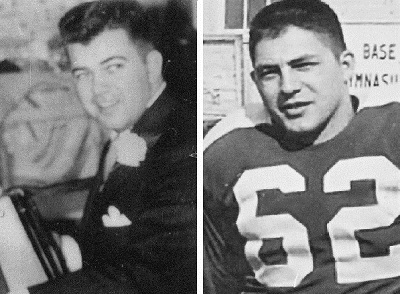 Frank Sokasits, Anita's dad (left); Richard Nicklas, Margaret's dad (right) Now back to those other passengers named Szokasits, who traveled on the same ship as my grandmother in 1912. I was finally able to figure out how they were related to her. From the ship’s record, I knew that the young woman on the ship, Anna Szokasits, was married and was on her way to New Jersey. She had two small children with her, a boy (Edward) and a girl (Anna), leading me to speculate that her husband’s name might be Edward, too. Their 1920 census record confirmed this and told me that the couple went on to have two more girls, Agnes and Catherine. But the trail ended abruptly after that. I later discovered that Edward, who was a saloonkeeper, had drowned mysteriously in the Delaware River in 1925. The 1930 census showed that Anna and the children had relocated to California. But even after compiling all this, I had not been able to establish how Edward and my grandmother were related, and I didn’t want to guess. It was a great feeling to finally hit upon the birth records that showed that Edward’s father, Ignatius, and my great-grandmother’s father, Ferdinand, were brothers. With this piece in place, I reached out to a descendant of Edward and Anna’s—Catherine’s son—whom I had located through on-line research. In 2018, we got to talk. He was able to share a little more about his mother’s family and their experiences once in California, while I filled him in on what I knew of the relatives he had back east. In just a few short years, I have gone from thinking my grandmother was an orphan with no known family in the world, to discovering just how far from the truth that is. It has been so rewarding to connect with real live human beings who can corroborate or correct my theories and add details to what I know, thereby bringing this new family history to life. And the treasure trove of pictures I have received from so many generous family members has been equally thrilling. In these photos of people I have never known, I see resemblances to my family that are as clear as day. The journey has not ended, and there is still so much I want to know about my grandmother and her relatives. But the Burgenland Bunch, and everyone I have met because of my involvement with the group, has already enriched my life immeasurably. I can’t thank them all enough! |
||||||||||||||||||||||||||||||
3) TRIP TO AUSTRIA AND HUNGARY (by Frank Paukowits) This summer I traveled to Austria and Hungary with my family. It was a ten-day trip, which included three days in Burgenland, three days in Vienna, three days in Hungary, and one day for travel. We wanted to travel on non-stop flights to and from New York City (NYC). Direct round-trip flights from NYC to Vienna were running about $1,500, flying with either Austrian or Delta Airlines, while similar direct flights flying to Budapest by LOT (Polish Airlines) were running about $1,000. Since there were seven of us who were part of our group, the difference in cost flying to and from Budapest would save us a total of $3,000; as such, we chose this option, which also fit nicely into our planned itinerary. Because of the size of our group, we had to rent a large van for our trip to Burgenland. We rented from a firm called Buchbinder, which specializes in large vehicle rentals. We picked the van up at the Ferenz Liszt Airport in Budapest. Our game plan was to drive down to Burgenland, and then travel to Vienna, drop off the van there and then go to Budapest by train to spend the final leg of our trip in Budapest before flying home to NYC. The trip from Budapest to southern Burgenland (Güssing area) by car takes about three hours. While the trip from Vienna to our part of Burgenland is somewhat shorter (about two hours), I believe the lower cost of flying into Budapest makes it the better option, especially if there are a number of travelers in your group and you would like to visit Budapest, which is a very nice destination. Also, I suggest flying on a Thursday, which gets you into Burgenland on the weekend when your ancestors have more time to socialize and there are more events going on, which you might find enjoyable. 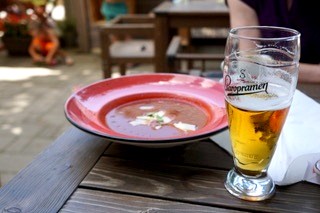 On our way to Burgenland, we stopped in the Lake Balaton region in Hungary for a light lunch. This is a very nice resort area where locals come to relax and spend time on the lakeside beaches. It provided a well-needed rest for my son-in-law who was doing all the driving on the trip. Then…. on to Burgenland we went! In Burgenland we stayed at the Schwabenhof Gasthaus in Hagensdorf. It is centrally located and affords very comfortable accommodations. Also on the property is a pool and a very nice restaurant. The staff is very friendly and helpful. 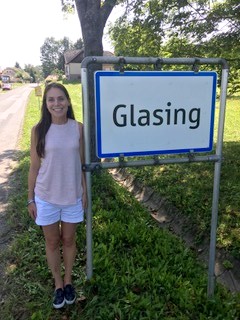 My wife has many relatives in the town of Glasing, whom we visited on Friday. The Uhudler (a delightful wine indigenous to southern Burgenland) flowed generously, and the relatives were very hospitable and welcoming. After that, we returned to the Schwabenhof, where we had a sumptuous family meal, including kürbis (pumpkin) soup, schnitzel and various strudels. On Saturday, we visited the Burgenländisches Auswanderermuseum in Güssing. The Museum contains memorabilia relating to the massive exodus of emigrants from Burgenland in the late 19th and early 20th centuries. It also has material that has been provided by the Burgenland Bunch. It’s definitely worth a stop if you have some time on your hands. After that we strolled through Güssing and continued on to the Burg, the 800-year-old castle/fortress that served as a bastion to ward off would be invaders. Such castles are typical throughout Burgenland, and a visit to one them should be part of any itinerary. 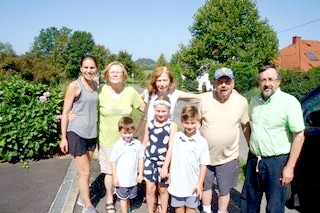 After
visiting the castle, we had dinner with my wife’s Weinhofer cousins and their families at the Burg,
which was very pleasant. That night we went to a Volksfest in Hagensdorf. The music was great and the drinks flowed
continuously. We enjoyed ourselves immensely. Those Burgenländers sure know how to party! After
visiting the castle, we had dinner with my wife’s Weinhofer cousins and their families at the Burg,
which was very pleasant. That night we went to a Volksfest in Hagensdorf. The music was great and the drinks flowed
continuously. We enjoyed ourselves immensely. Those Burgenländers sure know how to party!The following day we visited Graz, Austria’s second largest city after Vienna. It’s about an hour’s drive from Burgenland. The highlight of the trip was our visit to the Clock Tower [the "Liesl" Glockenturm], which is perched on top of a hill near the center of the city. We took in the vistas there, and enjoyed a refreshing beer. The city has some beautiful architecture and getting around is a little easier than in Vienna, which is much more congested. We walked around and had a bite to eat at a local restaurant. We then returned to Hagensdorf for our final nostalgic night in Burgenland before leaving the next day for Vienna. 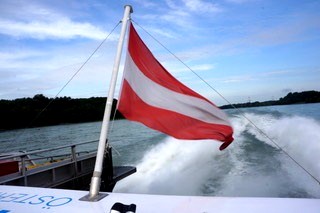 In
Vienna, we stayed at the conveniently located Marriott City Center Hotel next to Stadt Park. We did
the typical tourist things while in Vienna (that is, visited St. Stephan’s Cathedral [Domkirche St. Stephan],
went to the Prater amusement park, took a boat trip on the Danube to Bratislava, capital of Slovakia, etc.). In
Vienna, we stayed at the conveniently located Marriott City Center Hotel next to Stadt Park. We did
the typical tourist things while in Vienna (that is, visited St. Stephan’s Cathedral [Domkirche St. Stephan],
went to the Prater amusement park, took a boat trip on the Danube to Bratislava, capital of Slovakia, etc.).What you must do if you find yourself in Vienna is to eat Tafelspitz. It’s beef that is boiled in a tasty soup. It doesn’t sound appetizing, but it is terrific. And the place to eat it is at one of three Plachutta restaurants in Vienna, which are renowned for this dish. Our final leg of the trip was Budapest. Budapest actually is broken into two major sections: Buda and Pest, which are divided by the Danube River. Both sides are equally nice and desirable from the standpoint of hotel preferences. Our hotel, the InterContinental, was on the Pest side. Again, in Budapest like Vienna, we did “touristy” things, going on a hop-on-hop-off bus to see the sites. Hungarians are noted for their cuisine. You must try their goulash soup and paprikash chicken. Tasty and with a little zip, I had each on different nights, and thoroughly enjoyed the meals. We left Budapest ten days after we had arrived, filled with wonderful experiences and memories. In conclusion, I hope I’ve captured the essence of my trip and have provided useful information for anyone planning a visit to this area. |
||||||||||||||||||||||||||||||
4) "MARGINAL" ENTRIES IN CIVIL BIRTH RECORDS 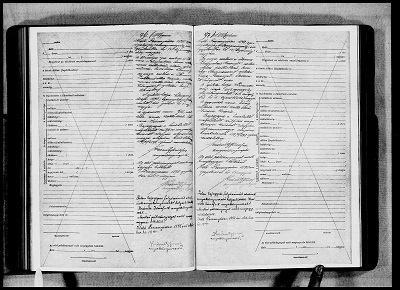 In past newsletters, we looked
at "marginal" entries found in the Hungarian civil marriage and death records for the years of the "long form"
entries, 1895-1906. This month we conclude with a similar "marginal" entry from the civil birth records for that same
period. If you studied the earlier articles, you should not be surprised by what we will see in a marginal birth entry, as
there is great bureaucratic similarity among the types of entries, with only the "core" data section differing. As a result,
my approach in explaining the entries will also be similar to my earlier articles... so here goes. In past newsletters, we looked
at "marginal" entries found in the Hungarian civil marriage and death records for the years of the "long form"
entries, 1895-1906. This month we conclude with a similar "marginal" entry from the civil birth records for that same
period. If you studied the earlier articles, you should not be surprised by what we will see in a marginal birth entry, as
there is great bureaucratic similarity among the types of entries, with only the "core" data section differing. As a result,
my approach in explaining the entries will also be similar to my earlier articles... so here goes.Marginal entries are identified by a big X over the pre-printed sections and a lot of handwritten Hungarian text in a marginal area. Like for the marriage and death records, this indicates a vital event that took place outside of the local recording district but is being added to the local records because the person or family involved has legal standing in a town in the local recording district. [In the US, this type of vital record is called a return or delayed birth certificate, and we have similar such returns for marriages and deaths.] Even though deciphering these marginal entries is difficult, they are the records that may overcome a roadblock for ancestors who apparently "disappeared" from the records, leaving you to wonder what happened to them. The example I show above is a randomly-selected marginal death entry from the Pecsenyéd (Pöttsching) civil recording district birth records. Marginal birth records have a fairly consistent format (especially within a recording district). However, they are free-form entries, so can and do vary. Nonetheless, we will try to provide the keywords you can key on to find the relevant name, date and places. Below is a blow-up of the actual handwritten entry from above (the digital image is here: familysearch.org/...?i=178&cc=1452460&cat=86949), should you wish to explore further). 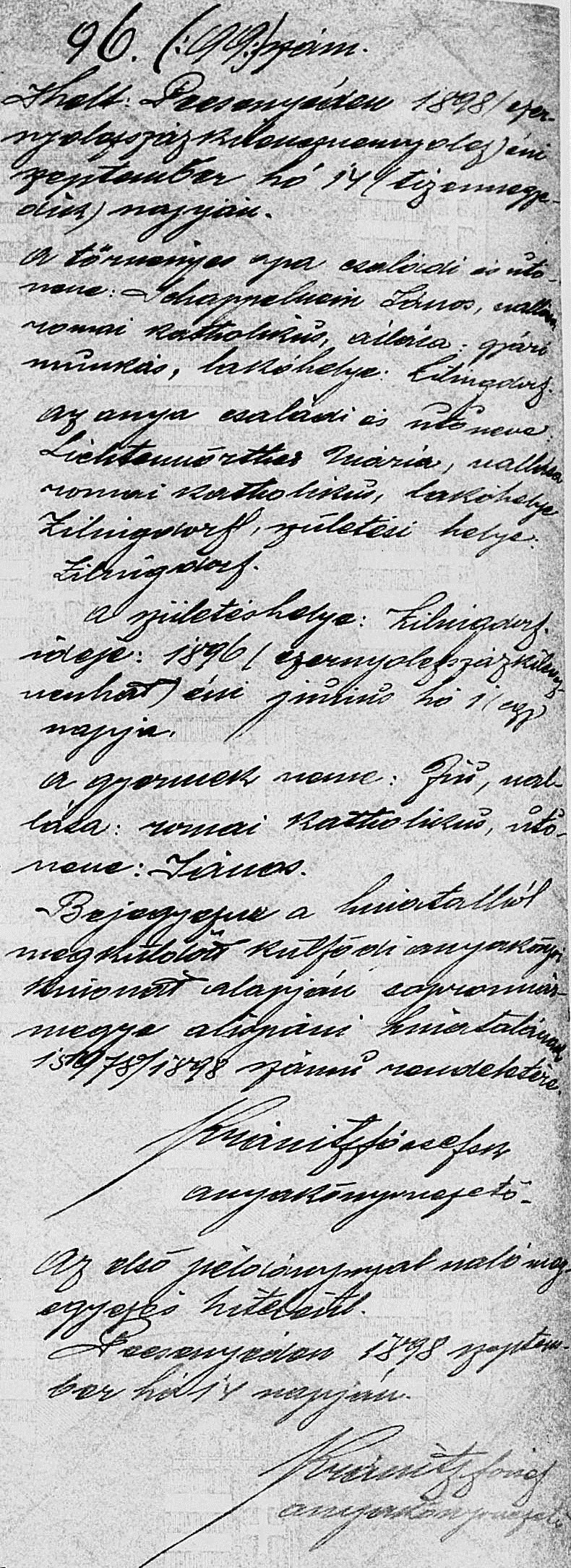 When it comes to marginal birth records, the full name (first and last) of the child is not presented as a whole; rather, the given name is in one part of the record and the surname in another part (as part of a parent's name). Thus if you are searching for a specific child, your initial search strategy should be by either surname or given name, not both. The problem with searching by given name is that there was not much variety among such names in a village, so you'll likely find a lot of false positives (i.e., you find the correct given name but the wrong surname). However, a search by surname has its own problems, especially given the large number of children born out of wedlock and then later legitimized by the marriage of the parents: what surname should you search for? While I won't recommend which approach you should try, I'll point out where to look under each strategy (given/sur- name) as I talk about the elements of the entry. And yes, there are "standard" elements in these entries, usually (but not always) set off as separate paragraphs. As I did for the other types of marginal entries, I'll show the transcription and translation of the text of my example in the table below, numbering, in the leftmost column, the parts of the entry so I can point you to the right section during my discussion, where I talk about each part in succession. Do note that the handwriting in my example entry is sneaky difficult, as the writer forms a number of what should be quite different letters in highly similar ways, so do not be surprised if your first interpretation differs from mine!
Now let's look more closely at some parts of the entry: |
||||||||||||||||||||||||||||||
5) HISTORICAL BB NEWSLETTER ARTICLES Editor: This is part of our series designed to recycle interesting articles from the BB Newsletters of 10 years ago. However, this time I jump back twenty years, to when Gerry wrote about the many monetary units in use in the Burgenland region... THE BURGENLAND BUNCH NEWS - No. 66 October 15, 1999 BURGENLAND CURRENCY - CURRENT & HISTORICAL - by Gerry Berghold The many different types of currency and coin circulating in the Burgenland area over the centuries would have required the services of an accountant. Most aristocrats or merchants used money changers, bankers, stewards or keepers of the exchequer. I'm only going to list later-period coins and monetary units originating in Austria or Hungary. Be aware many others circulated quite freely. [Ed Note: the "current" era when this article was written in 1999... keep that in mind when Gerry says a coin is in current use; many have been superceded by the Euro and other currencies.] Conventionsthaler - a thaler struck in 1753 following agreement that 2 gulden were to be worth 1 thaler. Best known after 1780 was Maria Theresia thaler. Ducat - well known silver or gold coin circulating for years in many forms throughout Europe. First gold ducat issued in Venice in 1284. Filler - low value coin of Hungary corresponding to the heller. In 1892 worth 1/100th of Austrian krone. In 1925 1/100th of a pengo. 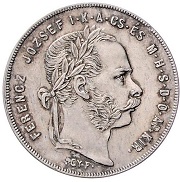 Currently
1/100th of a forint. Currently
1/100th of a forint.Florin - name from gold coins of Florence first struck in the mid 13th century. Became interchangeable with other gold coins of equal weight. Forint - Hungarian equivalent of the florin equal to 100 filler. Again introduced in 1946 to take the place of the pengo. Now aluminum. Fünfzehnkreuzer - 15 kreuzer coin of Austria struck 1659-64 under Leopold I to pay for Turkish War expenses Gold gulden - main gold coin of southern Germany from 15th century. Issued to supercede gold coins of Italy (like florin). About the size of a ducat but not as pure or heavy in gold. Groschen - chief silver coin of the Holy Roman Empire, now 1/100th of the Austrian schilling (in Germany the name can be used to mean a 10 pfennig piece). Gulden - original gold coin of Germany, Austria and Hungary. Corresponded to the florin, and Dutch guilder. In use 14th to 17th centuries. Silver thaler was also referred to as gulden. Haler - smallest unit of Czech currency =1/100th koruna. Equals Hungarian heller. Heller - silver coin first struck in Germany in the 13th century. Spread to Austria when struck as a copper piece. In Austria equal to 1/100th of a krone from 1893-1925. Koruna - silver coin of Hungary 1892-1925. Kreuzer - Austrian copper coin equal to 1/100th of a florin as late as 19th century. 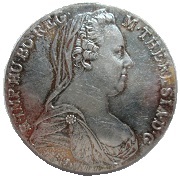 Krone
- Austrian silver coin from 1892-1925 with a value of 100 hellers. Pictures a crown. Krone
- Austrian silver coin from 1892-1925 with a value of 100 hellers. Pictures a crown.Maria Theresa Thaler - best known of all silver thalers in use 1753-1960's (throughout mideast). Date frozen at 1780. High quality minting and silver content. Has portrait of Empress Maria Theresa. Still a fine Austrian souvenier. 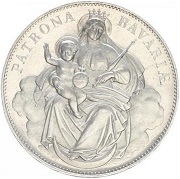 Marienducat
- various ducats which portrayed Virgin Mary. Hungarian struck in 17th century, also Marienthaler. Marienducat
- various ducats which portrayed Virgin Mary. Hungarian struck in 17th century, also Marienthaler.Mark (from 1924 Reichsmark - now Deutschmark) - German coin struck in 1506. In silver in 1873, value was set as 100 pfennigs. Pengo - silver coin of Hungary 1925-1946 = 100 filler. Pfennig - well known German coin originated as silver denier, later (16th century) copper piece, now worth 1/100th of a mark. It, penny and pengo are all derived from the Roman denarius. Schilling - main monetary unit and coin of Austria since 1925. Divided into 100 groschen. Name relates to English shilling. Value fluctuates between .08 and .09 dollars. Thaler - the predecessor and progenitor of the dollar. Originated in the Tyrol and Bohemia. Large silver coin originally equal in value to a gold gulden. First minted in 1518 in "Joachimsthal" mine (Joachim's Valley mine) hence "thaler". Became popular on an international scale. Accepted everywhere. When Austrian gulden was introduced, value was set as 2 gulden = 1 thaler. Ungaro - Italian name for Hungarian ducat. Source: "Dictionary of Coin Names," by Adrian Room. Routledge, Keegan, Paul Publishers, 1987). |
||||||||||||||||||||||||||||||
6) ETHNIC EVENTS LEHIGH VALLEY, PA Sunday, Nov 10: Sunday Dance at the Coplay Sängerbund. Music by the Josef Kroboth Orchestra. Info: www.coplaysaengerbund.com Saturday, Nov 16: Stiftungsfest of the Alpenrose Schuhplattlers at the Lancaster Liederkranz. Info: www.lancasterliederkranz.com Sunday, Nov 17: Sunday Dance at the Coplay Sängerbund. Music by the Emil Schanta Band. Info: www.coplaysaengerbund.com Friday, Nov 22 - Sunday, Dec 22 (weekends): Christkindlmarkt in Bethlehem. Info: www.christmascity.org/christkindlmarkt Friday, Nov 22 - Sunday, Dec 22 (weekends): Weihnachtsmarkt in Bethlehem. Info: www.discoverlehighvalley.com/listing/christmas-huts-on-main/3718/. Saturday, November 23, 1-4 pm: Lehigh Valley / East Coast BB Meeting at the Coplay Sängerbund (205 South 5th Street, Coplay, PA ). Please RSVP by contacting Vanessa at HooftyRN@msn.com. Please bring your laptop if you’d like. Everyone is welcome to join the group! [Late addition] Sunday, Nov 24: Sunday Dance at the Coplay Sängerbund. Music by The Polkateers. Info: www.coplaysaengerbund.com Friday, Nov 29: German Christmas Show at the Evergreen Heimatbund in Fleetwood. Info: www.evergreenclub.org NEW BRITAIN, CT Friday, Nov 1, 7 pm: Heimat Abend. Austrian Donau Club, 545 Arch Street, $3. Music by Frank Billowitz. Friday, Nov 15, 7:30 pm: Heurigan Abend. Austrian Donau Club, 545 Arch Street, $3. Music by Schachtelgebirger Musikanten. ST. LOUIS, MO Sunday, Nov 10, 1:30 - 4:30 pm: Burgenland Ancestral Research Workshop. Two of our local researchers, Rita Oswald Grace and Dan Steger, will be sharing tips on how to find information on our Burgenland ancestors. Please plan to join us in the East Meeting Room at the Headquarters Branch of the St. Louis County Library, 1640 S. Lindbergh Blvd. St. Louis, MO 63131. Bring a laptop if you have one. Refreshments will be provided. Please let us know you are planning to attend. There will be plenty of space! Contact info: mcwilliamstheresa1@gmail.com UPPER MIDWEST Sunday, Nov 3, 12:30-5 pm: Upper Midwest Burgenland Bunch Fall 2019 Meeting will be held at the Maplewood Public Library, 3025 Southlawn Drive, Maplewood, MN. |
||||||||||||||||||||||||||||||
7) BURGENLAND EMIGRANT OBITUARIES Irma Donnes (née Kenyeri)  Irma Marie Donnes passed away at her
home in Gretna, Louisiana on Tuesday, October 8, 2019 at the age of 99. Irma Marie Donnes passed away at her
home in Gretna, Louisiana on Tuesday, October 8, 2019 at the age of 99.Wife of the late Nelson Donnes. Mother of John B. Donnes (Carol Hebert Donnes) and Chadwick N. Donnes. Grandmother of Denise Lindemann (Dr. Wayne Lindemann), Michele McKeon (Dr. David McKeon), and Nicole Donnes. Great grandmother of Maggie Anne Lindemann. Daughter of the late Ludwig and Maria (Simonovits) Kenyeri. Sister of the late Theresia "Resi" Kenyeri Owens (the late Ray). She is survived by many nieces, nephews, and relatives. Best friend of Delia Hernandez and close friend to many others. Irma was born in Rechnitz, Austria and came to America as a teenager. She was a member of the Gretna Historical Society and the German-American Cultural Center of Gretna. She was a longtime employee of Maison Blanche, D.H. Holmes, and Dillard's. Her family would like to thank Passages Hospice for their heartfelt care. Relatives and friends are invited to attend the memorial gathering at Lake Lawn Metairie Funeral Home, 5100 Pontchartrain Blvd in New Orleans, on Tuesday, October 15, 2019 from 11:30 AM to 1:30 PM. Interment will follow at Metairie Cemetery. In lieu of flowers, please consider making a donation in her honor to a charity of your choice. To view and sign the family guestbook please visit www.lakelawnmetairie.com. Published in The Times-Picayune from Oct. 11 to Oct. 12, 2019 |
||||||||||||||||||||||||||||||
| END OF NEWSLETTER (Even good things must end!) |
||||||||||||||||||||||||||||||
|
Burgenland Bunch Newsletter, copyright © 2019 by The Burgenland Bunch |
 News
News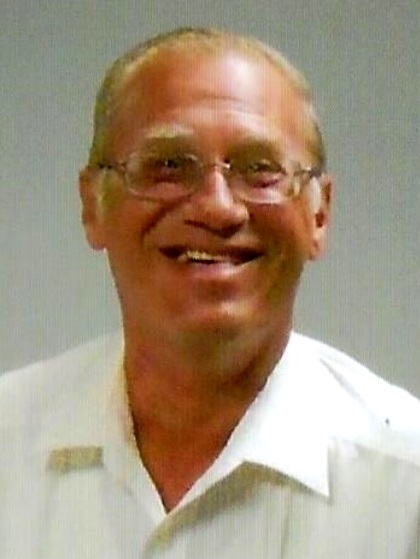 Joseph
"Butch" Weber: One of the stalwarts of the ethnic music scene in the Lehigh Valley died in October. Joe Weber, 68,
of Whitehall, was son of Joseph and Margaret (Meyer) Weber. His father was born in Northampton, grew up in Eisenberg an der
Pinka and later emigrated back to the US. His mother's parents came from Neustift bei Güssing.
Joseph
"Butch" Weber: One of the stalwarts of the ethnic music scene in the Lehigh Valley died in October. Joe Weber, 68,
of Whitehall, was son of Joseph and Margaret (Meyer) Weber. His father was born in Northampton, grew up in Eisenberg an der
Pinka and later emigrated back to the US. His mother's parents came from Neustift bei Güssing. Feedback
from Newsletter Readers: The "Historical BB Newsletter Article" from last month, "Changes to a Major
Burgenland Immigrant Enclave: Allentown, PA", rang a bell for member Joe Rios, who wrote:
Feedback
from Newsletter Readers: The "Historical BB Newsletter Article" from last month, "Changes to a Major
Burgenland Immigrant Enclave: Allentown, PA", rang a bell for member Joe Rios, who wrote: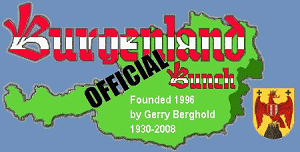 The
Facebook Bunch (from Vanessa Sandhu):
The
Facebook Bunch (from Vanessa Sandhu): 